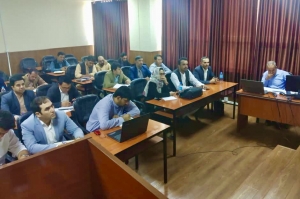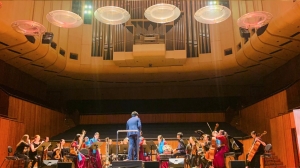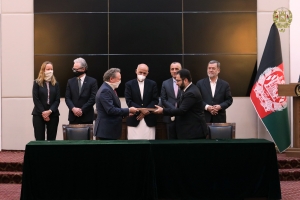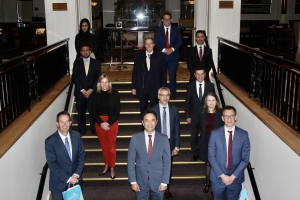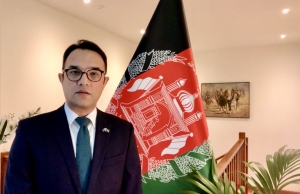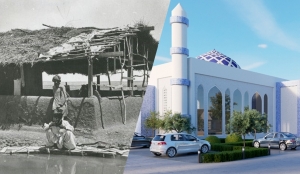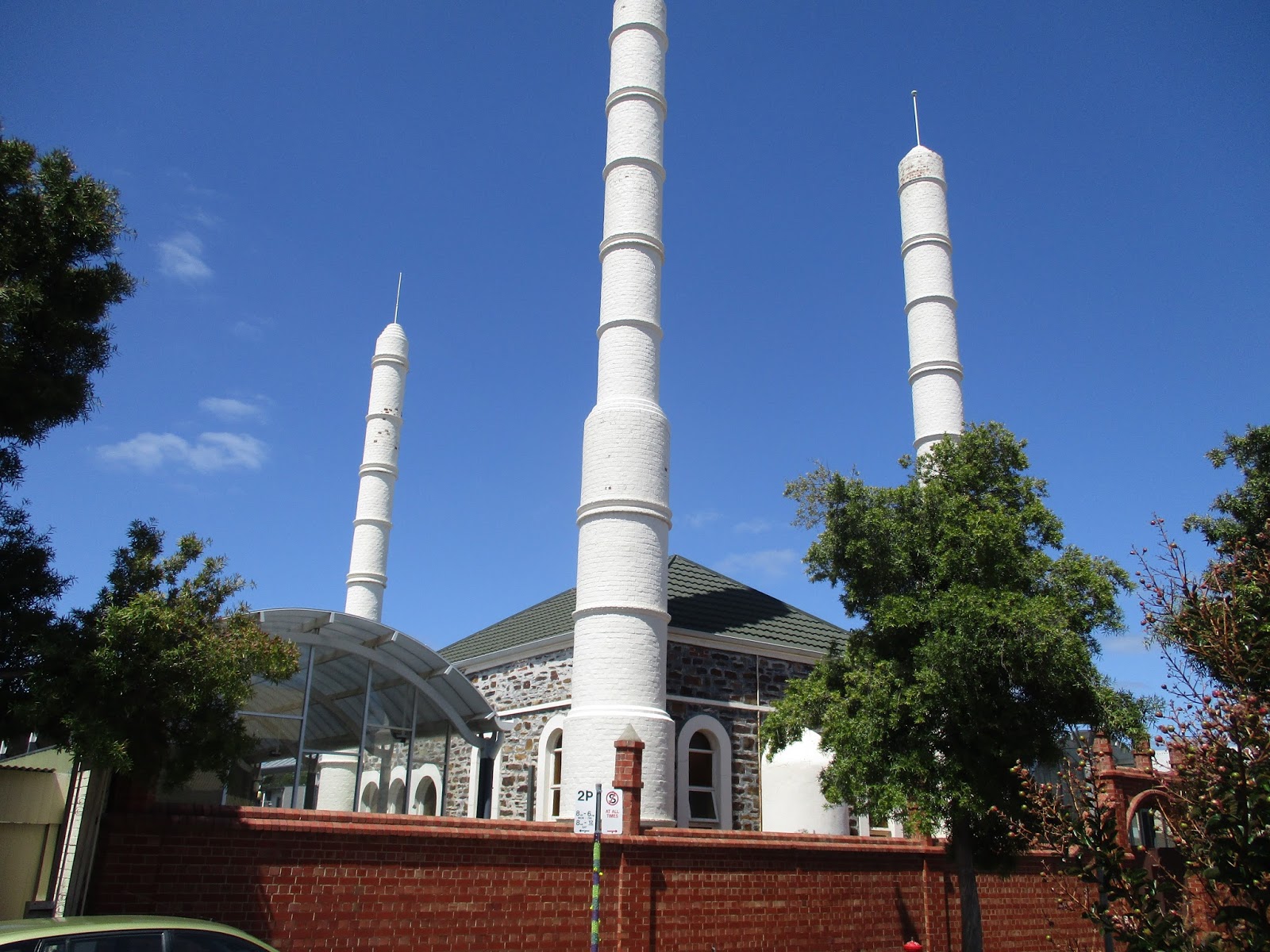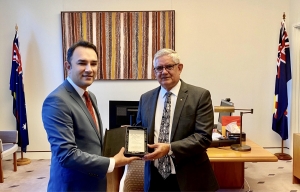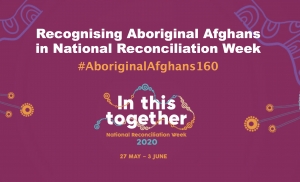A Collaboration Agreement between Kabul Polytechnique University of Afghanistan and the International Water Centre (IWC) of Australia was signed on 6 October 2020 during a virtual teleconference held between Kabul and Canberra with attendance of officials and academic counterparts from both countries.
The signing ceremony was held few weeks after the commencement of the first Master Programme on Integrated Water Resource Management (IWRM) in Afghanistan with collaboration of IWC and Griffith University of Australia.
Recalling the Afghan higher education delegation Australia visit in November 2018 as a stepping stone for this initiative, Ambassador Wahidullah Waissi welcomed the signing of the agreement and highlighted the importance of Master Program on IWRM as one of the most crucial areas of capacity building needs for Afghan young professionals. He hoped that the project to be fully implemented.
The Master programme has already been started on 13 September based on a Memorandum of Understating (MoU) between Kabul Polytechnic University, International Water Centre and Griffith University of Australia that was signed in Kabul on 19 July 2019.
Due to COVID-19 restrictions, the programme is designed in mixture format where participants will have the flexibility of both virtual and physical attendance.
Funded by Asian Development Bank and supported by Australian expertise, the program will provide higher education opportunity for dozens of Kabul Polytechnic University students and engineers from Ministry of Energy and Water of Afghanistan on IWRM by Australian and Afghan professors and experts.
The higher education cooperation between Australia and Afghanistan was better shaped since the first historic visit by H.E President of Afghanistan in April 2017 and is more focused on the key areas of economic development including mines and minerals, agriculture and dryland farming and water resource management.
The 14th of October 2020 marks the 1-year anniversary of the fantastically received and unique performance of the Zohra Orchestra in front of a packed Sydney Opera House audience. The heartfelt performance of Zohra, Afghanistan’s first entirely female musical Orchestra, in one of the world’s most distinctive and prestigious music venues, represented a new era of friendship between the Afghan and Australian peoples, and displayed the everlasting hope, resilience, and progress of Afghan culture, women and youth. The performance was part of the Embassy of Afghanistan’s celebrations for the 50th anniversary of Afghanistan-Australia relations and centenary of the reclamation of Afghan independence. We invite you to commemorate this occasion, to reflect on this brilliant display of Afghan culture and inauguration of new progress in people-to-people ties with Australia and to enjoy this performance of classical Afghan and Western music played by the emerging pioneers of the promotion of Afghan culture worldwide.
The Zohra Orchestra was created in 2015 by the founder and director of the Afghanistan National Institute of Music (ANIM), Dr Ahmad Sarmast, and is made up of Afghanistan’s young female musical talent playing traditional Afghan and Western instruments. ANIM was itself created in 2008 in Kabul with the goal of reigniting the enduring flame that is Afghanistan’s music, which had found itself extinguished during the cultural dark age of Taliban control. The orchestra, under Dr Sarmast’s tutelage, won in 2017 the Queen Soraya Award and Freemuse Award, and in 2018 the Montluc Résistance et Liberté Prize. The Orchestra has notably performed at the World Economic Forum, the British Museum and the University of Oxford. Its performance in the Sydney Opera House, undoubtedly the Southern Hemisphere’s most iconic musical venue, marked the first time it has hosted a performance of any Afghan group or musician.
The concert at the Sydney Opera House was a powerful event during a remarkable year for both Afghanistan-Australia relations and all Afghans worldwide. In 1919, a century before the concert, Afghanistan reclaimed its sovereignty and established itself among the global community of free and independent nations. In 1969, Afghanistan and Australia formally established diplomatic relations. However, this was not the beginning of the two countries’ long and fruitful friendship. In 1860, the first of the Afghan cameleers arrived in Australia, marking the beginning of an era of cultural exchange and exploration, as the cameleers pioneered new paths through the harsh Australian outback, linking together remote communities, charting new routes and providing the backbone of the gold rush. The Cameleers, Australia’s first Muslims lived, prayed, married and died in the outback, with their descendants carrying on their legacy even today. The performance of the Zohra Orchestra marks the present extent of Afghan-Australian cross-cultural and people-to-people ties, which have flourished and growin since 1860.
It was also an opportunity for the Australian public to experience the seldom-mentioned art of Afghan music. Afghanistan, inhabited by great civilisations spanning back thousands of years, maintains a rich and diverse tradition of music, tying together communities and cultures across the country’s mountain ranges, passes, fields, forests and deserts. From Attan in Afghanistan’s south and east, the Falak tradition among the jagged peaks of Badakhshan province to the tea-house music of the North, the diversity, uniqueness, living tradition and beauty of Afghan culture is resounding. Poetic traditions tie together the instrumental and vocal elements of the music, expressing the rich and ancient stories that music tells. The transformative and emotional power of music was also on display, one year ago, as the young female performers used music to express their identities as young Afghan women, living during hopeful, yet uncertain times.
The Zohra Orchestra’s impactful and emotive performance was testament to the vast progress that Afghan women, youth and culture has made in the past two decades. It also illustrated the absolute necessity of keeping Afghanistan’s rich culture alive and empowering the roles and voices of women in society. During the dark ages of Taliban rule, women were systematically repressed, not being allowed to develop, learn and live as basic human rights express. Music and entertainment were also banned. It is now imperative that, leading into uncertain times for Afghanistan and its people, with peace talks between the government and the Taliban underway, that the fundamental rights of women and girls are upheld. Without that, the rich cultural heritage, resolute bravery and soulful hope displayed one year ago by the members of the Zohra Orchestra may be lost forever. Their message of resilience and identity brings together the wishes of the entire Afghan people, for peace, fairness, progress and prosperity for all.
Read more about the last year's event in Australian media outlet:
https://www.sbs.com.au/news/afghanistan-s-all-female-orchestra-is-hoping-to-revive-music-banned-under-the-taliban
https://www.abc.net.au/radionational/programs/musicshow/zohra-afghanistan-all-female-orchestra-australian-tour/11589662
https://www.abc.net.au/classic/read-and-watch/news/first-all-female-orchestra-from-afghanistan-tours-australia/11590106
https://www.sbs.com.au/language/english/from-kabul-orphanages-to-the-opera-house-all-female-afghan-orchestra-debuts-in-australia
https://www.culturalpulse.com.au/afghanistans-all-female-ensemble-zohra-orchestra-set-to-tour-australia/
https://www.smh.com.au/culture/music/to-show-the-beauty-of-afghanistan-all-female-afghan-orchestra-challenges-tradition-20191004-p52xmc.html
https://www.curvemag.com/events/performance/meet-zohra-afghanistans-first-all-female-orchestra/
https://tolonews.com/arts-culture/afghan-orchestra-plays-world-class-opera-house
https://www.gandhicreations.com.au/post/zohra-orchestra-reflecting-on-the-power-of-music-to-craft-identities-unite-cultures-and-save-lives
https://baztab.news/article/1175866
https://www.sbs.com.au/news/audiotrack/afghanistans-all-female-orchestra-helps-revive-music-banned-under-taliban
https://www.governor.nsw.gov.au/photo-galleries/zohra-orchestra/
https://cityhubsydney.com.au/2019/10/zohra-orchestra-all-female-ensemble-of-afghanistan/
https://www.sydneyartsguide.com.au/all-female-afghanistan-orchestra-coming-to-sydney/
https://www.sydneyoperahouse.com/events/past-events/Contemporary-Music/2019/zohra-orchestra.html
http://www.buddhistcouncil.org/events/zohra-orchestra-all-female-ensemble-of-afghanistan/
On 25 August 2020, the Embassy of the Islamic Republic of Afghanistan in Canberra organized a friendly reception at the Hayat Hotel in Canberra for few members of the Australia-Afghanistan Parliamentary Friendship Group, namely Mr Andrew Wallace MP and Chair of the Group, Mr Julian Hill MP and Vice Chair of the Group, Ms Angie Bell MP, Mr Josh Wilson MP, Mr Tony Zappia MP, Mr Luke Gosling OAM MP and Senator Louise Pratt.
HE Wahidullah Waissi, Ambassador of Afghanistan to Australia and non-resident Ambassador to New Zealand and Fiji, welcomed the MPs and Senator Pratt to the event and appreciated their engagement, dedication and continued support in bilateral relationship and backing the Afghan Government’s ongoing efforts towards lasting peace, stability and democratic governance.
Mr Andrew Wallace, on behalf of the group, thanked the Embassy of Islamic Republic of Afghanistan for the warm hospitality extended to the members of the group who made it to attend and reiterated the strong support and enthusiasm of all members of the group for enduring partnership between Australia and the Islamic Republic of Afghanistan on various fields.
The participants deliberated on a range of topics of mutual interests including the Afghan peace process, the impacts of COVID-19 on Afghan society and economy, future of Australian assistance and engagement with Afghanistan and people to people bonds between two friendly countries.
The Australia-Afghanistan Parliamentary Friendship Group was inaugurated on 6 December 2017 at Australian Parliament House. It comprises of 24 members from both chambers and major parties. The member list of the Australia-Afghanistan Parliamentary Friendship Group (AAPFG) is the following:
Mr Andrew WALLACE MP (CHAIR), LNP
Mr Julian HILL MP (VICE-CHAIR), ALP
Hon Kevin ANDREWS MP, LP
Ms Angie BELL MP, LNP
Sen Andrew BRAGG MP, LP
Hon Anthony BYRNE MP, ALP
Mr Vince CONNELLY MP, LP
Mr Milton DICK MP, ALP
The Hon Joel FITZGIBBON MP, ALP
Mr Steve GEORGANAS MP, ALP
Mr Patrick GORMAN MP, ALP
Mr Luke GOSLING OAM, MP, ALP
Sen Hollie HUGHES MP, LP
Mr Matt KEOGH MP, ALP
Sen Kimberley KITCHING MP, ALP
Hon Nola MARINO MP, LP
The Hon Brendan O’CONNOR MP, ALP
Ms Julie OWENS MP, ALP
Mr Graham PERRETT MP, ALP
The Hon Amanda RISHWORTH MP, ALP
The Hon Warren SNOWDON MP, ALP
Ms Maria VAMVAKINOU MP, ALP
Sen David VAN MP, LNP
Mr Josh WILSON MP, ALP
بسم الله الرحمن الرحیم
I am honoured to deliver this statement on the occasion of 101 anniversary of Afghanistan’s Independence Day. Despite COVID-19 disruption, I am grateful for all of you for making your time in joining us to the virtual celebration of this historic event.
I would like to begin with a message of sympathy with the families and friends of those who have lost their loved ones during this unprecedented pandemic. I also wish quick recovery to the affected ones. As the cure has not developed, the virus still hits cities, disturbs economies and changes the pattern of our lifestyles. Let me thank all those men and women who serve as medical staff, essential workers and security personnel who made big sacrifice during this difficult time while the rest of us stayed safe at homes.
The Embassy of the Islamic Republic of Afghanistan in Canberra is excited to celebrate the independence day across different cities in Australia, New Zealand and Fiji and engage members of all communities to join in the virtual activities while we observe COVID-19 regulations.
A century and a year ago in 19 August 1919, Afghans under the leadership of King Amanullah reclaimed Afghanistan’s independence. The reformist and visionary King set the foundations of modern Afghanistan on democracy, freedom, rule of law, gender equality and other constitutional values to which the Afghan nation still continue to fight and resist for to sustain and safeguard those values.
Last year both Afghanistan and Australia celebrated its 50 years of diplomatic relations through a series of successful events in deferent states of Australia as well as in Kabul. However, 2020, marks an extra special occasion as it observes the 160th anniversary of the arrival of Afghan cameleers to Australia, whose history and legacy the Embassy has been sharing this year. The contributions of these cameleers and their descendants is a true testament to the mutual friendship shared by Afghanistan and Australia. On this 101st Independence Day the Embassy will be carrying their message of peace and prosperity, and looks forward to the next chapter of Afghanistan’s future.
Afghanistan and Australia enjoy a steadfast bilateral and multilateral engagement. Since 2001, Australia’s partnership with Afghanistan has scaled up at different levels from security to economic development, health, education and women empowerment. Let me briefly reflect on the generous support and assistance of New Zealand to Afghanistan as well. Since 2003, New Zealand’s contribution in security and development sectors in Afghanistan has been substantial.
په آسترالیا، نوی زیلاند او فیجی کی میشت گرانو هیوادوالو:
تاسو ټولو ته زموږ د ګران هیواد د خپلواکۍ د بیرته اخیستلو کلیزې مبارکي وایم او په تیر کال کې د افغانستان او آسټرالیا د سیاسي اړیکو د پنځوسمی کلیزی د لمانځلو په برنامو کې د همکارو اتحادیو فعال ګډون او برخه اخیستنه او د سږ کال د هیواد د خپلواکۍ کلیزې په لمانځلو کې ستاسو له هڅو څخه په کلکه مننه کوم.
با استفاده از این فرصت اجازه دهید دو پیام جداگانه برای شما داشته باشم:
نخست طوریکه میدانید حفظ استقلال ، تمامیت ارضی و حاکمیت ملی افغانستان در طول تاریخ همواره سرخط کار دولت و ملت وطندوست افغانستان بوده است. طی دو دهه اخیر کشور ما حضور نظامی و مساعدتهای توسعه یی جامعه بین المللی را طبق تصامیم شورای امنیت سازمان ملل متحد و سایر نهاد های جهانی شاهد بوده است.
دولت جمهوری اسلامی افغانستان در حالیکه از فداکاری ها و مساعدت های شرکای بین المللی خود به شمول آسترالیا در مبارزه علیه تروریزم و افراطیت اظهار امتنان نموده و می نماید، از بدو حضور این نیروها و مساعدت های جامعه بین المللی گذار بسوی خود کفایی را در تمام برنامه های اولویت ملی خود مد نظر داشته و مجدانه آنرا تعقیب نموده و می نماید.
از جنوری سال ۲۰۱۵ بدینسو بار مسولیت دفاع از قلمرو، تمامیت ارضی و حاکمیت ملی افغانستان و رهبری تمام عملیات های رزمی بدوش نیروهای دلیر دفاعی و امنیتی کشور قرار دارد.
در عرصه اقتصادی نیز دولت افغانستان برنامه ها و پروژه های بزرگ اقتصادی و توسعه یی را درجهت کاهش فقر و نیل به توسعه اقتصادی در کشور طرح و تطبیق نموده و می نماید.
دوهم دا چی، سږکال په آسټرالیا کې د اوښبه افغانانو د لومړۍ ډلې د رارسیدو 160 کليزې سره برابر دی چې په 1860 کال کې دی براعظم ته راغلی و.
اوښبه افغانان هغه لومړني خلک وو چې اسلام یې آسترالیا ته راوړه.
هغوی د ژوند کولو لپاره نه یواځې د غان ټاونونو په نوم د اوسیدو لپاره ښارګوټي جوړ کړل، بلکه د غان په نوم د لومړي اورګاډي پټلۍ د جوړولو له لارې د براعظم د مختلفو برخو په پراختیا او اقتصادي ارتباط کې هم رول لوبولی.
د کووید۱۹ د محدودیتونو له امله، د افغانستان سفارت په دې مناسبت د خپل ټولنیز رسانی له لارې دا مهمه او تاریخي پیښه ولمانځله ترڅو دا مثبت پیغام ورسوي چې پدې هیوادونو کې د افغان کډوالۍ مثبت اړخونه حساب کیدی شي.
افغان دایاسپورا په آسټرلیا، نیوزیلینډ او فیجي کی د عامه اړیکو ژور او پراختیا کې رغنده رول لوبوي.
هریک شما در حقیقت سفرای فرهنگ، تاریخ، هنر و سایر داشته ها و ارزشهای ملی خود در کشور های میزبان هستید.
هر سال ما شاهد افتخارات بیشتری از افغانهای هموطن خود در عرصه های مختلف می باشیم و امید واریم این سلسله ادامه یابد.
همکاری شما در موفقیت برنامه های ملی مربوط به افغانستان مایه دلگرمی و افتخار است.
In conclusion, we are grateful to our International partners in particular Australia and New Zealand who are standing with us with courage and dedication bearing much sacrifices during difficult times of resilience. Our commitments to democracy and human dignity set forth in our Independence reclamation in 1919 remained unchanged. Safeguarding the gains, we jointly have had so far with the support of international community in the past 19 years in Afghanistan is vital.
Afghans, Islam and Australia from cameleers to the present day
Written and researched by Pamela Rajkowski OAM
Introduction
Aside from some pre-colonial contact between Makassan traders and the Aboriginal Yolgnu people in Arnhem Land, the start of Islam’s permanent presence in Australia was in the 1860s, with the arrival of Afghan cameleers who came and worked in the Australian outback as explorers and exporters. Large scale immigration of non-European Muslims to Australia only started with the dismantlement of the White Australia Policy, and the encouragement of multiculturalism. As of the 2016 census, Islam is the second largest religious grouping in Australia, with 604 200 Muslims living in Australia, or 2.6 percent of the population.
Afghan cameleers' mosques across Australia
The first four cameleers on Australian soil arrived in 1860 to assist on the Victorian government’s Burke and Wills expedition. These four Mohammedans [the universal term used until about the 1920s when it was replaced with Muslim or Islamic] and the camels originated from Peshawar, north-east India. After 1861 they did not establish any community.
1866 marks the arrival of the first commercial importation, funded by Thomas Elder of Beltana Station in South Australia, of 32 cameleers and 121 camels. The camels were purchased in camel markets in the Scinde and Rajasthan, and Kandahar in Afghanistan. The cameleers, contracted in the Scinde, Rajasthan and Afghanistan, were predominantly of Afghan descent and Moslem. Elder imported more Afghan cameleers and camels in 1884 and in 1893 to be used in South Australia, the Northern Territory and Western Australia. In the 1880s to 1910s Afghan camel merchants were travelling back to India and Afghanistan to purchase and import more camels and cameleers to work in New South Wales, Queensland and Western Australia. By the 1890s there were estimated to be about 1,000 Afghan cameleers in Western Australia and by 1901 3,000 overall in Australia.
The cameleers set up regular camel transport routes radiating out from depots in remote central locations and at railheads and married local women and set up families in Afghan camps or “ghan towns”. By the 1880s these Moslem haulers commenced erecting their spiritual centres, mosques, in their ghan camps or towns, in colonies across Australia. Camel community leaders or “jemidahs” or camel merchants required camel drivers to contribute to finance building the mosques frequently made of frail materials including wooden slabs or poles, mud walls, galvanised iron sheets and grasses for rooves. The call by the muezzin to prayer was heard from the 1880s to about the late 1920s across the outback. Eventually with more wealth accumulated in the cameleers’ population three large, permanent mosques were constructed. Today, the three permanent mosques are active, while the more remote mosques have been preserved or have disappeared. In total, about 16 mosques were erected across Australia by cameleers’ funds between 1884 and 1930s.
There were distinctive common characteristics noted in the Afghan cameleer mosques across Australia. Between the 1880s to the 1920s reporters, authors and travellers, such as in Coolgardie and Marree, recorded hearing the sound of the “call of the muezzin to prayer” across towns. There was no furniture in the interior of mosques. The faithful prayed on their prayer mats. No shoes were worn into the mosque. A “pond” or trough provided a source of water for ablutions. Inside a niche in the walls held the Koran. A picture of Mecca hung in each mosque. Particularly in the 1890s to 1910 a number of mullahs acting as “visiting priests” or “missionaries” sailed from Karachi to serve their distant faithful, at least in South Australia and Western Australia, who were far from home. As at the Adelaide and Broken Hill mosques there would be a separate smaller building, a kitchen. This was used for visiting mullahs, or holy men such as “sayids”, from distant countries or desert settlements visiting city mosques, and for cooking community feasts after the end of Ramadan. Trees such as date palms or fruit trees were planted in the grounds adjacent to the mosques. Today, the surviving mosques, active or preserved as historical memorials, built and funded by the Afghan cameleers, are visited by Australian tourists and overseas visitors. They are a part of the cameleers’ legacy and of Australia’s heritage.
South Australia
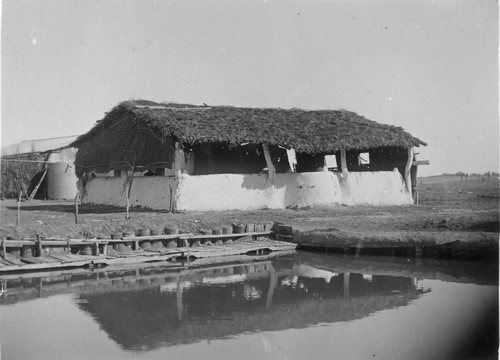 Marree/Hergott Springs: The “Ghan town” at Hergott Springs in northern South Australia was found by cameleers who moved from the camel depot at Beltana station to establish a new camel depot closer to the interior of the continent where camel transport was in great demand. By the 1870s the largest cameleer Ghan town in South Australia and Australia was known as “Little Asia” or “Little Afghanistan”. The site of the first Hergott Springs mosque, built in about 1884, was near natural springs or artesian water away from the town and on “Faiz Mahomet’s pad”. The building was a crude, rectangular structure of hand-made low bisque clay or mud walls, timber sticks as supports, and a cane thatched roof. The advantage of open walls was to allow breezes to cool the men at prayer during hot summer months. Nearby was the ablution pool filled with water supplied by an irrigation pipe system built by the wealthy camel driver and trader Sheik Abdul Kader. Wooden steps lead the washed worshippers from the pool to the entrance of the mosque. The spiritual leader was Mullah Assam Khan whose birthplace was Peshawar, located between Afghanistan and India. Date palms were planted near the ablution pond. This building lasted until about 1901.
Marree/Hergott Springs: The “Ghan town” at Hergott Springs in northern South Australia was found by cameleers who moved from the camel depot at Beltana station to establish a new camel depot closer to the interior of the continent where camel transport was in great demand. By the 1870s the largest cameleer Ghan town in South Australia and Australia was known as “Little Asia” or “Little Afghanistan”. The site of the first Hergott Springs mosque, built in about 1884, was near natural springs or artesian water away from the town and on “Faiz Mahomet’s pad”. The building was a crude, rectangular structure of hand-made low bisque clay or mud walls, timber sticks as supports, and a cane thatched roof. The advantage of open walls was to allow breezes to cool the men at prayer during hot summer months. Nearby was the ablution pool filled with water supplied by an irrigation pipe system built by the wealthy camel driver and trader Sheik Abdul Kader. Wooden steps lead the washed worshippers from the pool to the entrance of the mosque. The spiritual leader was Mullah Assam Khan whose birthplace was Peshawar, located between Afghanistan and India. Date palms were planted near the ablution pond. This building lasted until about 1901.
After the first mosque became dilapidated the cameleers built by 1910 a second thatched roof mosque, called the “Mahomadan temple”. It had a larger ablution pool, a water tank, a wooden pole lined platform for standing on to do ablutions, and some brush fencing. It was located closer to Sheik Abduk Kader’s date plantation. Inside the floor was carpeted and prayer mats laid on the carpet. This building was used until the 1920s when it was replaced by the third mosque.
First mosque in Hergott Springs [Marree] on “Faiz Mahomet’s pad”. Source: Pamela Rajkowski OAM
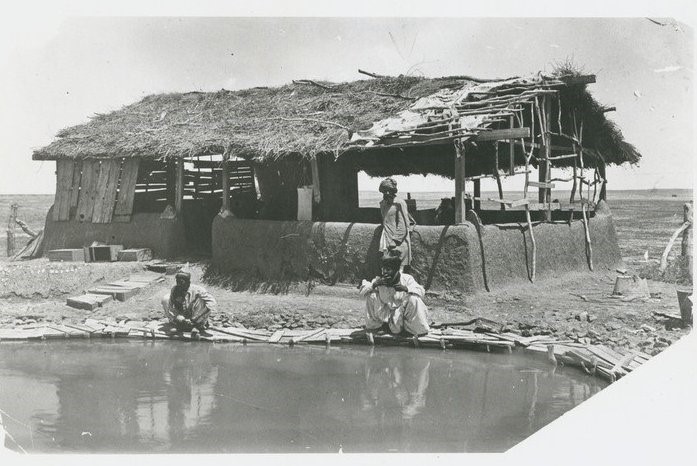
By 1920 the Afghan cameleers funded a third mosque made of more permanent materials, such as walls of galvanised iron sheets and pine poles, a pitched iron roof and a wood lined ablution pool. A verandah over the entrance was shaded by tall trees. When this mosque became disused it was pulled down. Local Afghan descendants recycled the sheets of galvanised iron in their own homes in Marree’s Ghan town. The carpets were taken to the Afghan mosque in Adelaide.
The second mosque in Marree built closer to Sheik Abdul Kader’s date plantation. Source: State Library of South Australia https://collections.slsa.sa.gov.au/resource/B+1534

In the early 1930s the Marree holy man Syed Goolamadeen, in white, stands beside the ablution pool of Marree’s iron mosque. Photo Source: Pamela Rajkowski OAM
Since the 2010s in Marree a replica of the first mosque stands in the second main street on the Ghan side of the town. It was a project from funds raised by Afghan cameleer descendants.
The replica of the first mosque in Marree’s second main street.
Adelaide
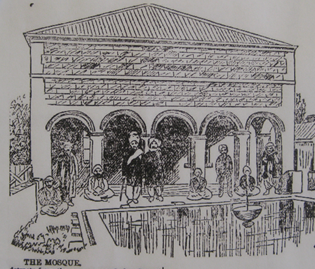 The “jemidar” of the first cameleers to arrive at Beltana station in 1866, Faiz Mahomet of Kandahar, also eventually an owner of camel strings and camel importer and employer of cameleers, managed the Afghan cameleers at Beltana station and at Hergott Springs from the 1870s to 1880s. Seeing that many would be permanently residing in Australia he wanted to provide them with a permanent mosque, a “home away from home”, as a spiritual centre where they could receive charity and care. In 1887 Faiz Mahomet purchased a piece of land for 450 pounds from the Adelaide City Corporation in Little Gilbert Street in the south-west corner of Adelaide. The square blue stone building with a stately dome was constructed over two years and opened in 1890. The grounds included an ablution pool with a fountain in its centre. Hadji Mullah Merbain, born in Kandahar, came from Coolgardie to be the first mullah in the Adelaide mosque. As the mosque’s mortgage was unlikely to be paid off in its two year time limit in 1893 Abdul Wade / Wadi, another wealthy camel merchant, camel importer and employer of cameleers in New South Wales, paid off the mosque’s mortgage debt with 293 pounds so that the mosque stayed in the hands of his fellow countrymen. He became the trustee of the mosque.
The “jemidar” of the first cameleers to arrive at Beltana station in 1866, Faiz Mahomet of Kandahar, also eventually an owner of camel strings and camel importer and employer of cameleers, managed the Afghan cameleers at Beltana station and at Hergott Springs from the 1870s to 1880s. Seeing that many would be permanently residing in Australia he wanted to provide them with a permanent mosque, a “home away from home”, as a spiritual centre where they could receive charity and care. In 1887 Faiz Mahomet purchased a piece of land for 450 pounds from the Adelaide City Corporation in Little Gilbert Street in the south-west corner of Adelaide. The square blue stone building with a stately dome was constructed over two years and opened in 1890. The grounds included an ablution pool with a fountain in its centre. Hadji Mullah Merbain, born in Kandahar, came from Coolgardie to be the first mullah in the Adelaide mosque. As the mosque’s mortgage was unlikely to be paid off in its two year time limit in 1893 Abdul Wade / Wadi, another wealthy camel merchant, camel importer and employer of cameleers in New South Wales, paid off the mosque’s mortgage debt with 293 pounds so that the mosque stayed in the hands of his fellow countrymen. He became the trustee of the mosque.
Cameleers funds financed the extensions of the Adelaide mosque. Camel drivers gave ten shillings a year and camel merchants gave one pound a year. By 1901 to 1903 funds, including a significant amount donated by Basha Gool, a Western Australian camel owner, afforded the addition of four red brick minarets, painted white, and a high red brick wall.
The Adelaide mosque or “Afghan chapel” was the first permanent mosque in Australia, the first city mosque and is the oldest permanent mosque in Australia.
By the 1940s the population of Afghan cameleers declined, and their sons took on different occupations, so there was no need for more Afghan cameleers to migrate to Australia. Few followers of the Moslem faith visited the Adelaide mosque. From the 1950s the congregation of the Adelaide City mosque was boosted by Muslims arriving from Bosnia, Yugoslavia, Pakistan, Africa and Indonesia.
The Adelaide mosque sketched in July 1890. Hadji Mullah Merbain, with a tall white turban and walking stick, stands near the centre. Four minarets were added in 1901 – 4. Source: Pamela Rajkowski OAM
Today the Adelaide City mosque, seen here with the white painted minarets and tall red brick wall, is state heritage listed. Source: Pamela Rajkowski OAM
Western Australia
Coolgardie: The development of the Western Australian goldfields in the 1880s and 1890s attracted hundreds of Afghan cameleers and camels. Jemidar Faiz Mahomet, Tagh Mahomet and other South Australian cameleers travelled to the goldfields and eventually independent camel owners sailed to Karachi to collect camels with camel handlers to bring into Western Australia. By 1892 the growing population of Afghan cameleers built two mosques in Coolgardie and they had two mullahs. The first mosque in their Afghan camp at Fly Flat at the eastern end of Coolgardie, the largest centre in the goldfields, was financed by Faiz Mahomet. Tagh Mahomet, his brother, and Goulam Mahomet were joint owners of the mosque. The mullah of the first mosque was a Kandahar man, Hadji Mullah Merbain. Later its gardener was another Kandahar man, Goulam Rassoul. Steps led to the entrance of its galvanised iron structure and a trough provided water for ablutions. If there was no water in the ablution trough because of extremely hot weather the faithful washed themselves with sand.
In 1987 Faiz Mahomet brought out a priest Mullah Il Lasman who had sailed from Karachi to say prayers in front of 200 “Mohammedans” squatted on carpets and prayer mats. Above the faithful was “a flag bearing the star and crescent “. After the service Faiz Mahomet provided a feast for his visiting mullah and congregation
The second mosque was based in the “Beloochi camp”. Its mullah, Mullah Mirza Khan, could deliver services in four languages [three were Arabic, Parsee, Pushtun or Afghan]. In 1897 after his service a banquet was organised for the congregation by Sirdar Abdul Baki, related to Faiz Mahomet and both related to the Ameer of Afghanistan. No photos survive of either of the two mosques in Coolgardie. [Coolgardie Miner, WA, 8 March 1897, pg 6, “Mahommedan festival, Afghan rejoicings.”]
Between the 1890s to the 1910s the large and dispersed cameleer communities had built seven small mosques across the goldfields. In 1910 the Collector of Customs, based in Fremantle, Perth’s port town, recorded mosques built near mining settlements distributed throughout the goldfields which had Afghan camel depots or camps. These were in Coolgardie [two], Mount Malcom, Leonora, Mount Magnet, Bummers Creek and Mount Sir Samuel. The Perth mosque made the eighth mosque in Western Australia.
Perth: The cameleers’ first permanent mosque in Western Australia, and the second such one in Australia, was located in Perth. It was designed and built between 4 June 1904 and 1906. By the 1890s Faiz Mahomet operated many camel strings from his five offices across the goldfields and employed many Afghan cameleers. Faiz Mahomet played a key role in founding the first permanent mosque in Western Australia. He provided funds to purchase a piece of land for 680 pounds in William Street in the city of Perth. The building of the “Mohammedan mosque” was supervised by Muhamed Hassan Musa Khan, another jemidah and principal Afghan boss of the camel men of the Coolgardie goldfields, and created by the Kandaharian Mahomet Allum. Faiz Mahomet collected funds from the goldfields cameleers to finance the building of the mosque. The structure of a rectangular building included a second storey, gilt tipped mouldings and steps up to a verandah. It was surrounded by a high wall.
On 13 November, 1905, Faiz Mahomet, initiator and financier of at least four mosques, two being Australia’s first two permanent mosques, that served the far flung cameleers Muslim community which was far from their homelands, and highly respected by the head of state of Afghanistan, Emir of Afghanistan, laid the foundation stone. The Emir Habibullah Khan was appointed trustee of the Perth mosque. Later both the building and the high wall surrounding the mosque were painted white. The Perth mosque was heritage listed in 1995. It has a vibrant congregation today.
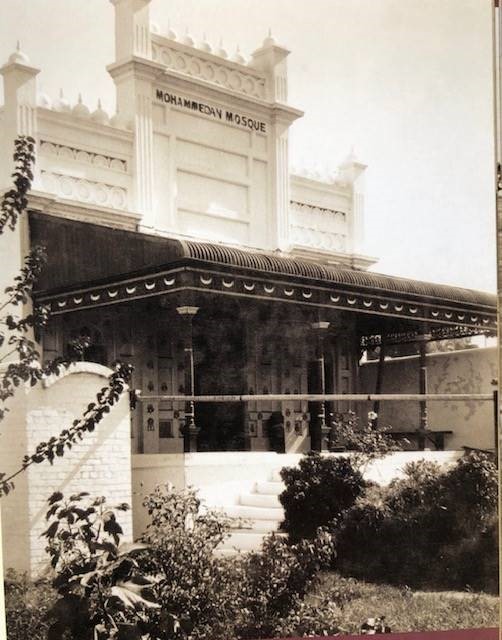
The Perth Mohammedan mosque pictured in the 1930s. Source: Pamela Rajkowski OAM
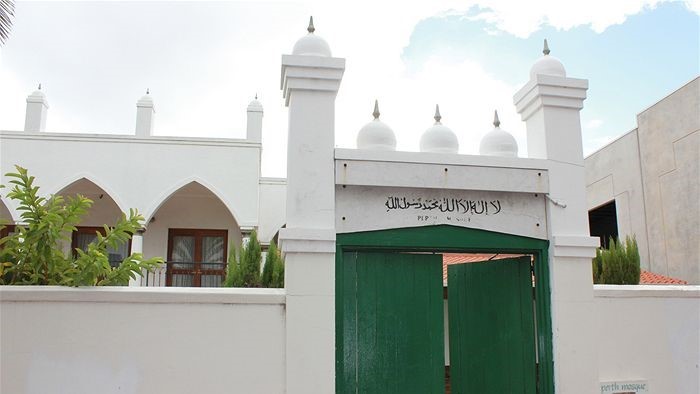
Perth mosque as it was painted in the 1970s. Source: ABC https://www.abc.net.au/local/photos/2012/04/12/3476007.htm
New South Wales
Broken Hill: Broken Hill had a larger North Camel Camp and a smaller West Camel camp and a mosque in each. The mosque in the North Camel Camp in Broken Hill was erected between 1887 to 1891. It was near a running stream which provided the worshippers with water for their ablutions. The men washed their feet over a ground level cement trough then walked on stepping-stones into the mosque. The corrugated iron and wood structure with a pitched roof was divided into two rooms, an ante room used to prepare the dead for burial and a prayer room. Prayer mats covered the floor. The mirab, the niche where the mullah stood reciting the prayers, was suggested by a painted arch on the north-west wall. In 1967 this mosque was saved from demolition by the Broken Hill Historical Society and in 2010 was placed on the NSW Heritage register. In 2018 to 2020 NSW has a restoration project underway to restore the mosque and yard and arrange its memorabilia in an added museum.
The Broken Hill’s North Camel camp iron mosque with date palms.
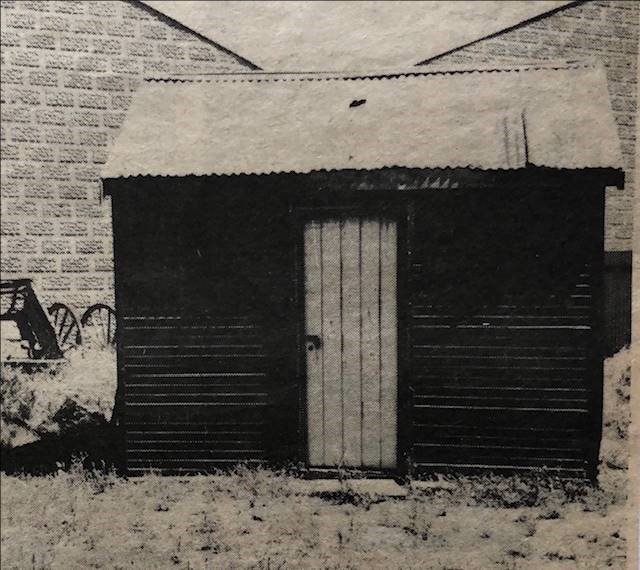
The smaller, one roomed tin and wooden mosque located in Broken Hill’s West Camel Camp. Source: Pamela Rajkowski OAM
Bourke: Bourke was the base of Abdul Wade / Wadi’s large camel carting company and many Afghan cameleers worked on routes that radiated out of that own. A camel owner Bye Khan built a one roomed, wood and galvanised iron house near the back door of the old house of Norbeen Perooz in the ghan town in Bourke. Perooz ‘s group of camelmen used the mosque. It had a pitched roof and small verandah. In 1996 the Bourke mosque was relocated from Hope Street to the Afghan section of the cemetery, in the hope of preserving it. It has been saved and is today preserved as a tourist attraction.
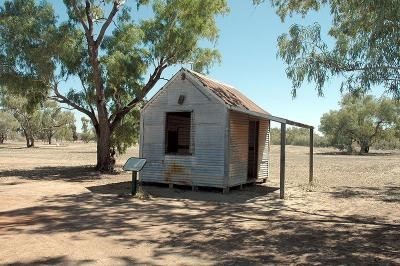
Bourke mosque. Source: Pamela Rajkowski OAM
Queensland
In the ghan town in Cloncurry in south-west Queensland the cameleers built a mosque from wooden slats. Until the late 1940s many pack saddles were seen beside the mosque. The last deed holder was Otta Khan. This mosque was pulled down after 1947 and its fruit orchard dried up.
Northern Territory
Alice Springs: The cameleers were more scattered in Alice Springs but still built a simple mosque near the camp of Satour, a significant camel merchant. It was made from timber with a thatched roof and open sides. Date palms were planted near the mosque. As it disintegrated, funds were raised for local cameleers and Moslems to build a permanent structure which still stands today. It is the third permanent mosque funded by Afghan cameleers.
Modern Afghan mosques in Australia
Blacktown Afghan Osman Mosque, New South Wales: The Blacktown Mosque, built by the Afghan community in Western Sydney, finished construction in 2014. It has since been involved in community projects for troubled youths in the Blacktown area, alongside its regular religious services.
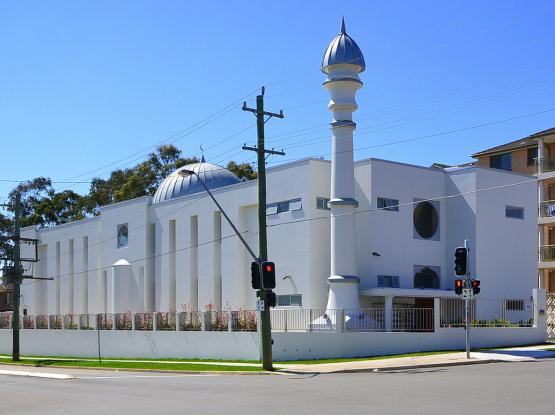
Afghan Islamic Centre & Omar Farooq Mosque, Doveton, Victoria: The already established Afghan Islamic Centre and Omar Farooq Mosque, is set to be relocated to a state-of-the-art facility in Doveton, Victoria. The new mosque, currently under construction, and is set to have large prayer, recreational, educational and conference facilities.
Photo source: Mosque Finder http://mosque-finder.com.au/mosque/blacktown-afghan-osman-mosque/
Conclusion
Today, Muslims play an integral part in Australia’s social, political and economic life. All major cities and regional hubs have notable Muslim communities from a wide range of national backgrounds, from Europe, Africa and Asia. Muslims are represented in both houses of Federal Parliament.
As of the 2016 Census, there are 46 800 Australians who reported as being born in Afghanistan. They are highly concentrated in the Ryde and Blacktown areas of Sydney, as well as Dandenong in Melbourne, where the second and third most spoken languages at home are Hazaraghi and Dari. Afghan Australians are active in political life, with Afghanistan-born Mina Zaki running in the division of Canberra in the 2019 Federal election for the Liberal Party. Afghanistan and Australia share a close relationship, with ever increasing economic and cultural ties.
Table: List of Mosques developed and owned by Australian-Afghans and their locations throughout Australia
|
Name |
Location |
Date of Construction |
|
Marree Mosque |
Marree, South Australia |
1884 |
|
Broken Hill Mosque |
Broken Hill, New South Wales |
1887 |
|
Central Adelaide Mosque |
Adelaide, South Australia |
1890 |
|
Coolgardie Mosque |
Coolgardie, Western Australia |
1892 |
|
Perth Mosque |
Perth, Western Australia |
1906 |
|
Afghan Mosque Alice Springs |
Alice Springs, Northern Territory |
1960s |
|
Blacktown Afghan Osman Mosque |
Blacktown, New South Wales |
2014 |
|
Afghan Islamic Centre & Omar Farooq Mosque |
Doveton, Victoria |
Under Construction, 2022 |
Disclaimer
This article was written and researched by historian and expert Pamela Rajkowski OAM, and added to by Ethan Vujanovic, an intern at the Embassy of the Islamic Republic of Afghanistan in Canberra. Material presented in this article is for the purpose of public awareness and learning and is only as accurate as the sources allow. The views and opinions expressed in this version are those of the authors and do not necessarily reflect the official policy or position of the Embassy of Islamic Republic of Afghanistan in Canberra or the Government of Afghanistan.
References
Text and Research by Pamela Rajkowski OAM, 28-30 April 2020
Maley, William. 2019. “Australia-Afghanistan relations: Reflections on a half-century". Australian Strategic Policy Institute.
Cover Photo Credit: IMPACT 3D/infinity render through Kabeer Azadzoy, Melbourne
Australia and Afghanistan’s relations can be traced back as far as the 1860s when the Afghan Cameleers came to Australia. In the midst of its 160th anniversary, Ambassador Wahidullah Waissi called on the Honorable Ken Wyatt AM, Member of the Parliament and Minister for Indigenous Australians, at the Australian Parliament in Canberra. Both sides discussed Cameleer's history and contributions to construction of transportation and communication and exploration of the outback Australia.
The Honorable Minister Ken Wyatt, who is also one of the proud descendants of the Cameleers, appreciated Embassy's anniversary celebration. They also discussed joint activities as part of the 160th celebration year to keep Cameleer's legacy alive.
Ambassador Waissi presented an engraved crystal block honoring the 160th Anniversary logo to the Hon Minister as a token of appreciation to the work, life and legacy of the Cameleers in Australia.
Australia and Afghanistan share a friendly and long-standing relationship. Relations can be traced back as far as the 1860s when Afghan cameleers came to Australia. In fact, 2020 marks the 160th anniversary of the arrival of these cameleers. The history and contribution of these cameleers and their descendants will be celebrated by the Embassy of Afghanistan in Canberra this year, with a special month of recognition from 15th June to 15th July. This will feature exclusive interviews with academics, as well as with descendants of the cameleers and Islamic-Indigenous communities. The Embassy looks forward to joining with these extraordinary individuals to shed more light on their ancestors.
From the late 1800s, as many as 20,000 camels and 2000 cameleers were contracted by European settlers for their invaluable knowledge of navigating semi-arid regions of the continent; with the Burke and Wills expedition of 1860-61 marking the first of such occasion. Not only did they contribute to the carriage of explorers, they also provided valuable assistance in transportation for the wool and mining industry, as well as major infrastructure projects including the Overland Telegraph Line; the Queensland Border Fence; the Transcontinental Railway; the Rabbit Proof Fence, and; the Canning Stock Route.
Upon their arrival, the cameleers were also the first to introduce the Islamic faith in Australia. They continued to wear their traditional clothing and adhered to their Muslim religion and devout practices – constructing rural Ghantowns as key focal points for the segregated communities. At first, these settlements were simply camel camps which provided shelter to Cameleers as they arrived or left for expeditions. Overtime, they would expand to incorporate more elements from their homeland including mosques, religious education, halal butchers, vegetable gardens and date groves. By 1888, rural Ghantowns had expanded into urban communities. The first metropolitan mosque in Australia was built on Adelaide’s Little Gilbert Street and became a national site of congregation for members during the fast of Ramadan.
During their inland travels, several cameleers formed a kinship with Indigenous Australians. Some agreed to carry traditional goods such as red ochre and the pituri plant across ancient trade routes; while others introduced sugar, tea, tobacco, clothing and metal tools to remote communities. In exchange, Indigenous Australians incorporated camel hair in their traditional artefacts and agreed to work with the cameleers during long desert treks by providing local information on water sources and plant material.
During the 1920s, as Australian transport motorised, the demand for Cameleer services fell sharply. Within the space of 20 years, several Ghantowns decayed beyond recognition and were deserted. By the 1940s, the last of the cameleers had all but disappeared from inland roads and tracks. When there was no longer a need for their services, most Cameleers returned to their homes in Afghanistan. Those who decided to call Australia home married either into Indigenous or European communities – their offspring growing up under the Islamic faith. But as older Cameleers passed away, younger generations began to integrate more fully with Australian society and the memory of their contribution faded away.
Today, several remnants of the Afghan Cameleers have been left behind. The kinship between the Cameleers and the Indigenous remains strong, with 1,140 Aboriginal and Torres Strait Islander Australians identifying themselves as Islamic-Indigenous – and the train between Adelaide and Darwin, The Ghan, has been named in their honour. A number of these proud descendants remain who are working hard to keep this legacy alive, and the Embassy is proud to share their stories as part of the 160th Anniversary celebrations.
We wish to invite you to join us in learning, sharing, and celebrating this important part of Australian history and the long and rich Afghan-Australian relationship throughout this month. We also request your ongoing support and interest into the future, as we introduce an Afghan Cameleer Heritage Week to be celebrated every year moving forward.
Follow hashtag #AfghanCameleers160 for updates through our twitter, facebook, YouTube and Instagram pages.
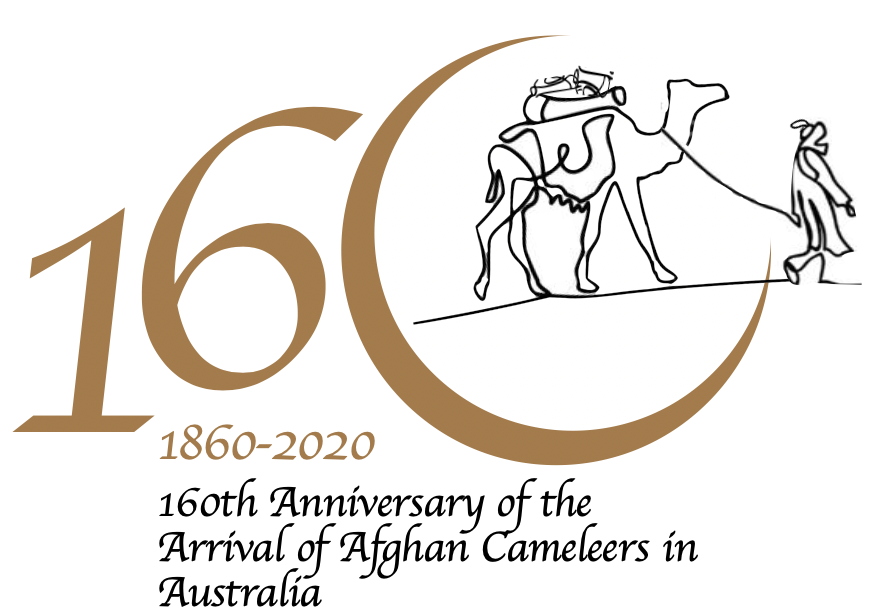
Recognising Aboriginal Afghans - Australian National Reconciliation Week
Reconciliation Week is dedicated to strengthening relationships between Aboriginal and Torres Strait Islander peoples and non-Indigenous peoples, for the benefit of all Australians. Running from May 27th to June 3rdevery year, this week aims to draw attention to the ongoing journey towards a just, equitable and reconciled Australia where all people have access to the same opportunities and quality of life. Reconciliation Week is about celebrating Country and acknowledging our share histories, cultures and achievements; and this is reflected in this year’s theme - ‘In This Together’.
At the Embassy of Afghanistan, this means celebrating and raising awareness of the togetherness shared by Aboriginal communities and Afghans, who first arrived in Outback Australia as cameleers 160 years ago. These cameleers played a crucial role in developing inland Australia, and along the way settled and established rural Ghantowns. The long and deep connections forged by those Afghan cameleers who befriended and married into Indigenous communities and started families are today told by their descendants, and this Reconciliation Week the Embassy will be shining a light on these stories.
There are many proud descendants of Aboriginals Afghans living in Australia. As the National Reconcilian Week in Australia celebrating the relationship between Aboriginal and Torres Strait Islander peoples and non-Indigenous peoples for seven days only, we are gratful to introduce the follwoing seven desendants of Aboriginal Afghans who have lived and still living in Australia. Our viewers and audience in Afghanistan and Afghans all around the world are interested to read more about their lives, history and backgroud.
We thank Pamela Rajkowski, a research author specialising in the history, heritage and contribution of the Australian Afghan Cameleers (1860 - 1930), for her gnenerous contribution to this profile. Pamela has regularly collaborates with Afghan Cameleer descendants across Australia. The views and opinions expressed in this article are those of the authors and do not necessarily reflect the official policy or position of the Embassy of Islamic Republic of Afghanistan in Canberra or the Government of Afghanistan. Material presented throughout this article is for information purpose and is only as accurate as the sources allow.
Eric Sultan
Eric Sultan is a descendant of one of these early cameleers, and is also very proud of his Aboriginal heritage. His grandfather, Sultan Mohammed, arrived in Australia from Kandahar, Afghanistan in the late 1800s and worked on transporting goods all across the continent; from South Australia across to Western Australia, and north into the Northern Territory and Queensland. Eric is passionate about ensuring that the contributions of these cameleers and their descendants, particularly those Aboriginal Afghans, do not disappear from the history books.
Rocky Khan
Rameth Nameth “Rocky” Khan, son of Oodnadatta Afghan camel owner Nameth Allik Khan and Aboriginal mother Alison Stokes, with his sister Miriam and brother Akbar travelled across country and states on their father’s camel strings. From the 1910s Rocky and Akbar worked and lived between Marree and Beltana as labourers and station hands. His first and second marriages were to Aboriginal sisters Cissie then Esther Dodd of Marree. The 8 children of Rocky and Esther were given both Afghan and English names (only 7 in the photo). Rocky Khan regularly attended Afghan cameleer family reunions at the Marree camel races.
Janice Taverner (née Mahomet)
Peer Mahomet came East Afghanistan, to South Australia in the 1880s with his camels. He was contracted to cart sleepers for the Beltana and north railway line. In 1908 he married Ruby Rita Stuart, 16, a part-Aboriginal girl of Port Augusta. In 1900 Mullah Assam Khan of Marree became his brother-in-law when Ruby’s sister Agnes married the religious head. Peer and Ruby Rita lived and worked at mining at Muchatoona then raised their 6 children in Beltana. One son, John Mahomet, was the father of Janice Taverner (née Mahomet) of Beltana, who as a very proud descendant has been very active over decades in preserving her Afghan-Aboriginal and Afghan cameleer heritage. In 2007, Janice Taverner (née Mahomet) become member of a memorial committee, Voyagers. It is an artwork celebrates the ‘Afghan’ heritage of Adelaide. It commemorates cameleers who came to South Australia from Afghanistan. The form of the Yoyagers artwork alludes to the cultures of these men and their lives in Australia.
Larl Zada
Khan Zada, born in 1869, came from Afghanistan to work with camel strings in Bourke, then Broken Hill and Wilcannia. Khan Zada and his part-Aboriginal wife Mary Payne had ten children who were given both Afghan and English names. One son, Abdul “al” Zada, married an Afghan cameleer’s daughter Ayshi Dadleh, of Marree ghan town. Their two children, Larl Zada and Irene Zada, are Afghan Aboriginal descendants who live in Port Augusta and have actively supported events over decades to celebrate their heritage.
Nazmeena Mulladad (née Cummings)
Nazmeena Mulladad grew up in an Afghan cameleer family in Central Australia. According to an ABC radio feature (see the link below) her childhood was unique nomadic, traveling with the Muslim cameleers, at the beginning of the twentieth century. She had a harsh but exotic lifestyle that revolved around the work, the camels and Muslim worship. Her father, Sayid Mulladad, a camel owner of Oodnadatta Ghantown, married May Humphries, a part-Aboriginal woman of Hermannsburg mission. The Afghan father insisted their five children, all daughters, had Afghan female names [Vera “Wira”, Roseann, Bebe, Zulka Nanadulka and Nazmeena]. The parents took the five girls on camel carrying trips and when in Oodnadatta sent the girls to the Oodnadatta school. Sayid was delivering supplies to places beyond the train line. She was living and working with Aboriginal families, who were employed by the Afghan cameleers. Nazmeena's mother would assist at their births as the local white settlers would not assist the Aboriginal people with medical problems. Sayid Satour, of Farina then Alice Springs, a Pisheen born in Quorto, India, married an Aboriginal woman from Hermannsburg mission. Their one child, William John Satour, married Vera Mulladad, both Afghan Aboriginal descendants. Some descendants of the Alice Springs Mulladads - Satours continued to be practising Muslims.
Mona Wilson (née Akbar)
Mona Wilson (née Akbar) is a descendant of Jack Akbar who came to Australia some time in the late 19th century as an Afghan cameleer. He married Lallie an Aboriginal Wongai from Western Australia in South Australia. Mona Wilson and her family are of Afghan and Aboriginal heritage. Mona Wilson, nee Akbar, was born in Renmark, SA, on February 28th, 1930. Eldest of 4 to Jack and Lallie. Mona spent her childhood and young adulthood in Renmark, travelling to Adelaide each year to attend Mosque with her father. After his death she moved to WA to be near her mother's country. Due to WA policies of the time, her children were removed from her care and she and her partner relocated to Victoria where she remained until after his passing. The entire family were not reunited until the 1980s. Mona was involved with many community organisations in her later life and left a legacy of love, peace, reconciliation and education of self. Her favourite saying...You are never too old to learn something new! Mona Akbar passed away in 2016 when she was 86 years old. In the eulogy given at her funeral, a friend of Mona wrote: "The biggest thing I remember is her smile. Welcoming, bright, cheerful and encouraging. Positive and upbeat. It drew people in and once engaged her eloquent story-telling abilities usually kept them spellbound, sometimes for just a few minutes, other times for hours. She was generous with her knowledge, always happy to share what she knew". A community tribute Facebook page is developed by Mona's grandchildren and friends who are descendants of Aboriginal Afghan Cameleers. The page is called "a place to share stories, photos, videos and memories of Mona Wilson, nee Akbar".
Stay with us and follow #AboriginalAfghans160, #Inthistogether and #7AboriginalAfg7days


